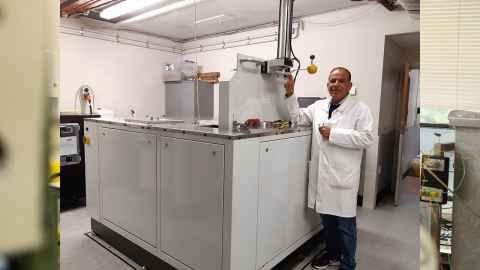Making food safe using pressure instead of heat
24 June 2019
Sixteen years of research at the University of Auckland has come to fruition and could change the way we pasteurise food, keeping it safe and also fresher and better for us.

Professor Farid often depicts the pressure exerted in high pressure processing visually, as two elephants standing on a coin.
The Ministry for Primary Industries recently approved the use of high pressure processing (HPP) as a process that kills the bacterial pathogens that are known to cause problems in New Zealand food, but one that involves very little heat.
This means the nutritional value or quality of the food isn’t compromised in the way it can be by heat.
Professor Mohammed Farid is a long-time champion of HPP, and he his team at the Department of Chemical and Materials Engineering have been researching the benefits of it since 2003.
Instead of heat, HPP treats food by using hydrostatic pressure. It’s more commonly known as cold-press - the fashionable way to pasteurise some fruit juices.
“They’re exactly the same thing but cold-press sounds more appealing to customers,” says Professor Farid.
HPP exerts pressure on the food instantaneously and uniformly, whatever the composition, size and shape of the food. “And because the pressure is uniform, it doesn’t smash the food,” he says. “And it inactivates large molecules like bacteria, but without affecting nutritional qualities, such as vitamins.
It can be used on a wide range of food products – from oysters to carrots, cheeses to jams.
In most cases it improves the shelf life of the food. “If you cut open an avocado in the fridge, it browns after a few days,” says Professor Farid. “But if you pressure treat it, it stays greener for much longer, because pressure inactivates the enzyme that causes browning.
“We have also treated Manuka honey, and found that we increased the bioactive compound in the honey.”
To put how much pressure the process involves in context: “The pressure cooker is only two atmospheric pressure, but we’re talking about six thousand atmospheric pressure which is higher than the deepest point in the sea. At conferences I tend to depict it visually – with an image of two elephants standing on a coin.”
HPP has been used in America, Japan and Europe for more than 20 years, but Australia and New Zealand has been slow to adopt it, partly because of delays in approval process, and the need for more information about how HPP can be safely applied to each food – how much time and pressure it takes to kill the idiosyncratic bacterial pathogens for each food, without affecting the quality and texture of the food.
He and his team have, over a decade of research, amassed that information for individual foods, which the food producers interested in the more modern technology can now consult.
“Thermal processing has been approved for 100 years,” says Professor Farid. “We know that if you take milk and heat it at 72 degrees for 15 seconds, it’s safe to drink. We haven’t had that knowledge for HPP.”
MPI still requires processors to carry out validation studies for HPP efficacy on a case-by-case basis, he says, “but now that it has been approved as an alternative pasteurisation process, I expect the industry to move very fast.”
Margo White I Media adviser
DDI 09 923 5504
Mob 021 926 408
Email margo.white@auckland.ac.nz